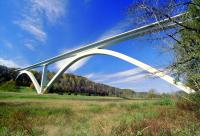Feb 2 2009
Virginia Tech's Center for Intelligent Material Systems and Structures (CIMSS) has teamed with Physical Acoustics Corporation (PAC), of Princeton Junction, N.J., to develop a suite of new technologies to provide a continuous, energy independent monitoring of the structural integrity of U.S. bridges.
 As the nation's bridges face the need for continual monitoring and rehabilitation, Virginia Tech mechanical engineers are participants in a research project to develop the Bridge Prognostic System, using an energy independent, active sensing system that can be observed from remote locations. Credit: Virginia Tech Photo
As the nation's bridges face the need for continual monitoring and rehabilitation, Virginia Tech mechanical engineers are participants in a research project to develop the Bridge Prognostic System, using an energy independent, active sensing system that can be observed from remote locations. Credit: Virginia Tech Photo
The National Institute of Standards and Technology (NIST) funded the $14 million project, with Virginia Tech's share at about $2 million. The Federal Highway Administration (FHWA) estimates that more than 70,000 bridges in the United States are structurally deficient. According to NIST, about 10,000 bridges are built, replaced or rehabilitated annually, but that leaves a significant need for a system to provide continuously updated information on the structural health of the remaining bridges. The proposed system would provide the data needed to better prioritize repair operations and to notify bridge owners of extreme events such as collisions.
The system proposed by PAC and Virginia Tech, along with two additional research partners, the University of South Carolina and the University of Miami, will include an innovative research method for "harvesting" or securing its own power from motions and vibrations in the bridge using piezoelectric materials, thus making it "energy independent," said Dan Inman, the director of CIMSS and the George Goodson Professor of Mechanical Engineering at Virginia Tech.
Piezoelectric materials are able to generate an electric potential when a mechanical stress in the form of vibration caused by traffic is applied.
According to Inman, the proposed instrument package will use acoustic emission (AE) sensing. When a crack or other flaw appears in a bridge, it emits acoustic waves. The sensors will detect these waves and monitor any changes.
The system is passive and non-destructive. The research targets both steel and concrete bridges.
The sensor data, transmitted through a wireless system, will feed computer models of the structure and a data interpretation system that will make assessments and predictions of the bridge's structural integrity on the basis of continuously updated information. Built-in self-check capabilities will eliminate the need for routine sensor maintenance.
The energy harvesting feature will eliminate the need for either a hard-wired power source for the hundreds of sensor nodes required or a reliance on batteries that would have to be regularly replaced. This aspect greatly reduces both installation and maintenance costs for the monitoring system, Inman added.
This NIST award is among the first under the agency's new Technology Innovation Program, created to support innovative, high risk, high reward research in areas of critical national need.
NIST considers the high-risk elements of the proposal to include the development of the energy harvesting system, the sensors themselves, and the data interpretation, damage assessment and health prognosis software.
Inman said that as "the inventory of bridges continues to age, routine inspection practices will not be sufficient for bridge owners to make informed decisions for safety and maintenance prioritization."
Continuous monitoring of the integrity of the bridge's structure is now needed. "The only feasible method is to allow engineers to observe various areas of concern such as a retrofit or a previous repair from a remote location. The monitoring can also be used as a preventative measure against terrorism or vandalism," Inman added.
Inman, who along with his students created a process allowing the use of smart materials to suppress and harvest vibrations, as well as the inventor of the self-sensing actuation principle for piezoceramic-based devices, explained this work will result in the use of a remote/online, self-powered global monitoring package, allowing for an early warning system. They plan to call it the Bridge Prognostic System (BPS), and it will be integrated into existing bridge management software to provide sound data for decision-making.
Multiple types of sensors will provide the information. "The primary advantage of the active sensing approach is that large areas can be scanned efficiently and cracks can be imaged remotely even though they are not actively growing," Inman said.
"It is clear from recent bridge collapses and the often reactive nature of bridge maintenance, that the major societal challenge of providing a safe and low-cost infrastructure system is not currently being met," Inman added.